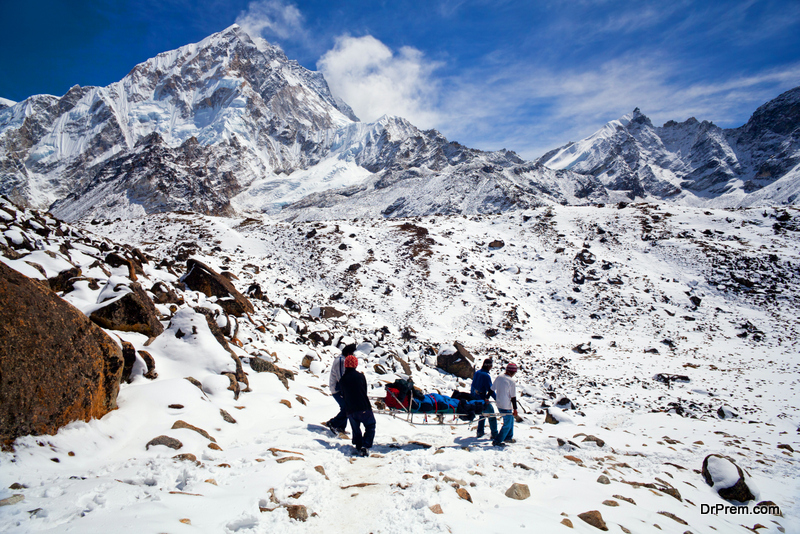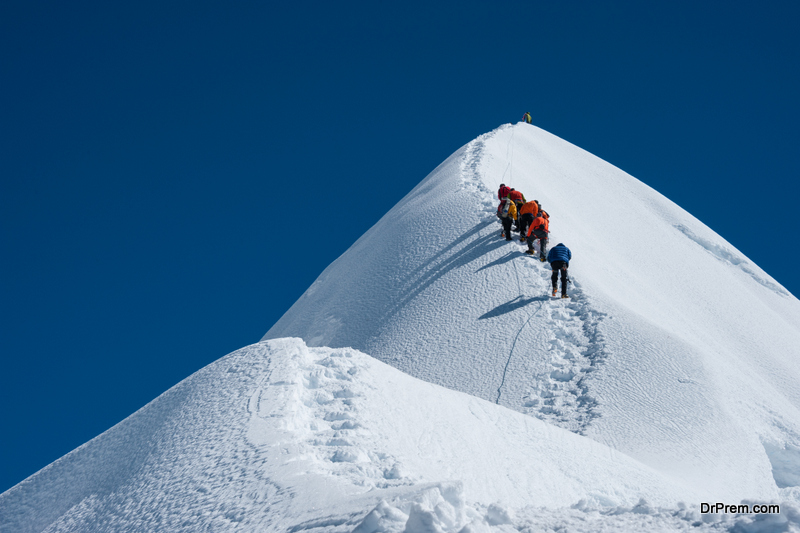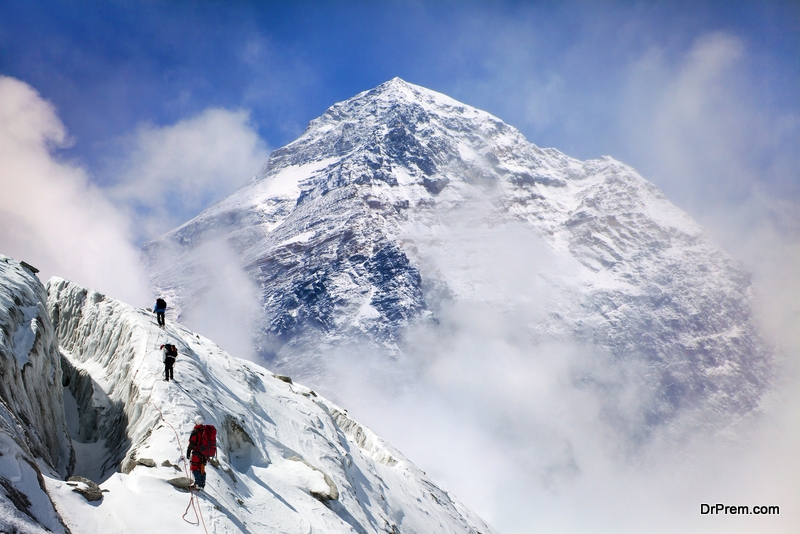Sixty-six years ago when Tenzing Norgay and Edmund Hillary became the first in the world to conquer Mt. Everest, never could they dream of traffic jam in the remotest peak. Mount Everest traffic jam has turned into a dangerous trend claiming valuable lives every year. It is common for climbers to wade through dead bodies while scaling the peak.
Blame it on the relentless issuing of permits by the Nepalese government, where novice and amateur climbers participate in this dangerous expedition only to breathe their last. A major part of the litter on Mt Everest comprises of the dead who succumb to high altitude sickness while crossing the Death Zone.
11 climbers died within a fortnight of May’19 – one short of 12 deaths in the same region back in 2012. Nepal being economically weak, generates handsome annual revenue of nearly $300 million by issuing these permits. A record number of 381 permits have been issued this season.
Mount Everest Traffic Jam – A negative impact of tourism:
 Deaths on the way to summit and overcrowding since last few years were brought into light by seasoned mountaineers. The government, it seems, hasn’t heeded the issue and is bent of commercialization of Mt Everest scaling.
Deaths on the way to summit and overcrowding since last few years were brought into light by seasoned mountaineers. The government, it seems, hasn’t heeded the issue and is bent of commercialization of Mt Everest scaling.
Reports say, about 600 people are known to have participated in the summit this year and has contributed to the Mount Everest Traffic Jam. Undoubtedly, the flaw lies in issuing of the permit, where there is no mention of specific guidelines to ensure the safety of the climbers and others following them. It only requires a medical certificate issued by a doctor deeming the participant medically fit.
What it doesn’t mention is the additional requirement of endurance and stamina which all “medically fit” persons do not have. The level of fitness required to scale great heights can be assessed only by professionals associated with recognized mountaineering institutes and organizations.
The climbers are neither aware of the severity of the climate nor they give time to acclimatize themselves before setting out to scale the world’s highest peak. The travel companies cropping up here and there offer “complete Mount Everest packages” to all and sundry without checking the vital traits a climber needs to have. What is even more appalling is that neither the climbers nor the travel companies care to learn from the disastrous incidents.
Hidden dangers of the Himalayan Beauty- The Death Zone:
Sagarmatha, as Mount Everest is called by the Nepalis, is ruthlessly unforgiving. It makes sure that people take scaling this peak seriously nurture specialized skills and not treat it as a casual picnic or selfie-shooting spot. People failing to realize this ultimately get lost amidst the covers of snow.
The higher Himalayan peaks fall under the typical Rain Shadow area, where a sudden drop in oxygen level can affect your brain’s normal functioning. This leads to altitude sickness, the single cause for the maximum number of deaths in this region.
Therefore, there are reasons strong enough to assign the stretch between 8000-8848 meters as the Death Zone. Ever since the doomed expedition of the British George Mallory in 1924, this Death Zone has engulfed more lives than any other places in this route. The situation is worsening with increasing Mount Everest traffic jam.
Imbalance of endurance and time management:
 Time management matters a lot in a region where oxygen levels start falling at an alarming rate. Minutes and seconds become precious and any delay owing to the Mount Everest traffic jam can be fatal.
Time management matters a lot in a region where oxygen levels start falling at an alarming rate. Minutes and seconds become precious and any delay owing to the Mount Everest traffic jam can be fatal.
If a climber has to wait for about 20-30 minutes to climb down owing to overcrowding, he/she fast loses the chances of survival. Even desperate attempts by Sherpa guides in providing extra oxygen cylinder cannot help untrained and less skilled climbers from falling unconscious finally slipping to death.
What happens to your body at the Death Zone?
The human body functions best at the sea level where the oxygen supply is adequate. As an individual scales the Death Zone over 8000 ft., the body experiences the following:
- Severe oxygen deprivation that kills the body cells minute by minute.
- Risk of heart attack and stroke increases.
- People suffer from poor judgment.
- Lack of oxygen shoots the heart rate to 140 beats per minute, raising the chances of a heart attack.
- To compensate for the oxygen deficiency, the body starts creating more hemoglobin causing thickening of the blood and difficulty in pumping by the heart.
- Brain swelling is common.
- Snow blindness, vomiting and loss of appetite are common as well.
Therefore, it is easy to imagine the plight of climbers when Mount Everest traffic jam forces them to queue in the death zone while on the way to reaching the summit.
Is traffic jam or “Summit Fever” causing more deaths?
Being overzealous and ignoring reality can be costly too. Kami Rita Sherpa, the man holding the record of scaling Mount Everest 22 times voices the same. He says, pushing one’s self inadvertently beyond the limits is the bigger reason for these deaths. Crowding on Mount Everest at a particular climate window is common.
Huge investments amounting to thousands of dollars are involved in this dangerous expedition. No climber wants to go back without touching the peak after coming so near, even if the body refuses to go further.
Research suggests that climbers often suffer from “summit fever”, a craze that drives them to race to the top even when their bodies are sending signals of giving out. According to an Everest climber and exercise psychologist, failing to check the oxygen supply in the tank is another risk factor. When climbing down, the body gets drained of energy and the climber has to meet with the most dreadful fate.
Need for stringent rules to prevent Mount Everest traffic jam:
A survivor of this traffic jam recovering in a hospital from frostbite emphasizes barring of untrained climbers to scale the peak. This can only reduce the recurrence of such unfortunate deaths on the peak.
The government certainly has an important role to play. There should be a standard qualification or fitness level set for climbing. Each climber must go through these tests successfully before setting off for Mount Everest.
One can easily take a lesson from China, who also runs expeditions through safer routes and stricter controls. It has been successful in preventing this negative impact of tourism. Nepalese officials are considering setting a level of proficiency for climbing and restrict the number of climbers each season. The sooner it is implemented, the safer it is for the climbers.
The environment part needs to be cared for as well. The litter on Mount Everest from tons of plastic bottles, cans, excreta, ropes, tents and bodies of climbers cannot be cleaned up, owing to heavy expenses.
Despite the zeal of human beings to conquer the unconquerable, scaling Mount Everest still poses one of the biggest physical and mental challenges on the Earth. Denying this ultimate truth can be costly as has been reflected a number of times through the series of deaths of unfortunate climbers.





